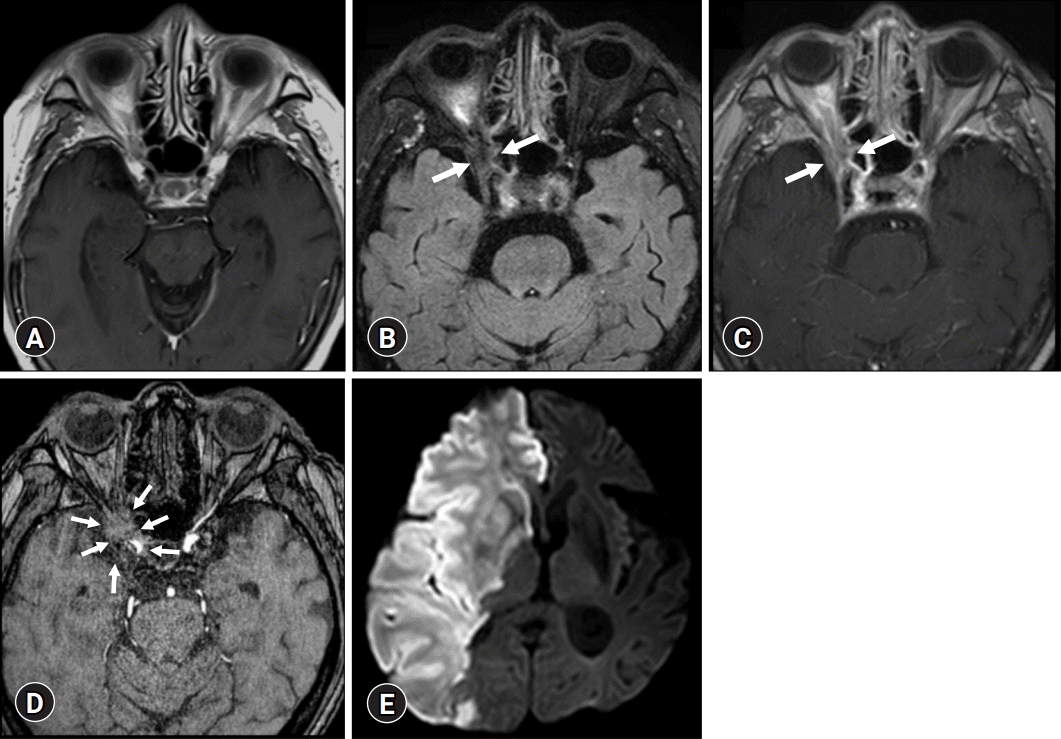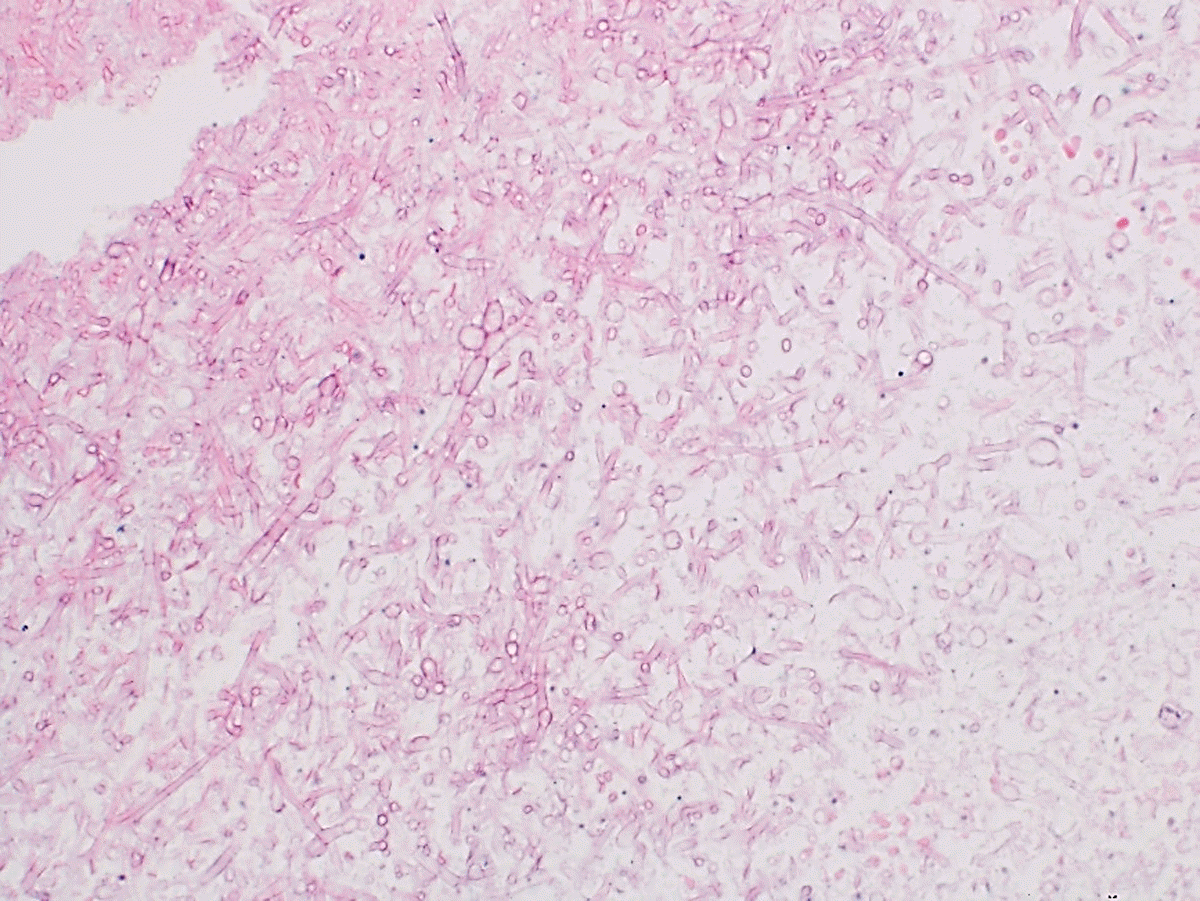Abstract
Invasive sphenoid sinus aspergillosis can mimic Tolosa-Hunt syndrome (THS), leading to frequent misdiagnoses and potentially fatal consequences. We report a case of invasive sphenoid sinus aspergillosis initially misdiagnosed as THS. A 79-year-old man presented with right periorbital pain, ophthalmoplegia, and loss of vision. Initial evaluations including magnetic resonance imaging (MRI), were normal. He was first diagnosed with THS based on clinical features. The disease progressed despite high-dose intravenous steroid treatment, and an enhancing mass-like lesion was found in the right orbital apex, cavernous sinus, and sphenoid sinus on follow-up MRI. Aspergillosis was eventually confirmed by sphenoid sinus biopsy. The patient developed cerebral infarction and finally died despite being treated with amphotericin B. Given that invasive sphenoid sinus aspergillosis may initially resemble THS, high suspicion and rapid histological examination are important for diagnosis.
Tolosa-Hunt syndrome (THS) is characterized by painful ophthalmoplegia caused by idiopathic granulomatous inflammation in the orbit and/or cavernous sinus. However, other conditions, such as cavernous sinus lymphoma, can mimic various features of THS, resulting in misdiagnoses [1]. Therefore, repeated neuroimaging studies and histopathologic confirmation are required to exclude other possible causes of painful ophthalmoplegia, specifically when the clinical course and radiologic findings are unusual for THS. We report a case of invasive sphenoid sinus aspergillosis initially misdiagnosed as THS.
Ethical statements: This study was approved by the Institutional Review Board (IRB) of the Korea University Anam Hospital (IRB No: 2022AN0044), and the requirement for informed consent from the patient was waived by the IRB.
A 79-year-old previously healthy man was experiencing periorbital pain in the right eye with visual impairment of counting fingers and binocular diplopia that worsened rapidly over the course of 7 days. He had a history of hypertension but did not have diabetes mellitus or thyroid disease. Nine months earlier, he had undergone craniotomy in the bilateral temporal region because of traumatic subdural hematoma from falling and had recovered without neurological sequelae. On admission, his body temperature was 36.8°C, and no jaw claudication or temporal artery tenderness were present. Neurological examination revealed ptosis and complete ophthalmoplegia with a normal pupillary response to light in the right eye. The rest of his neurological examination was unremarkable. Initial head magnetic resonance imaging (MRI) performed 7 days after symptom onset revealed no abnormalities except for postoperative changes associated with the previous subdural hematoma in the bilateral temporal areas and evidence of left maxillary sinusitis (Fig. 1A). Visual evoked potential showed low amplitude and delayed P100 wave at 188 ms after right eye stimulation. Laboratory findings were within normal ranges, except for erythrocyte sedimentation rate (32 mg/L) and C-reactive protein (82.52 mg/L). Cerebrospinal fluid (CSF) analysis revealed clear color, normal cell count, and normal protein and glucose levels. Immunologic serum markers, such as antinuclear antibody, antineutrophil cytoplasmic antibody, C3, C4, immunoglobulin G (IgG), IgA, IgM, and IgE concentrations, were within the normal range.
With the provisional diagnosis of THS, the patient was treated with intravenous high-dose methylprednisolone (1,000 mg/day) for 5 days. He experienced significant relief from orbital pain within 24 hours. On admission day 8, the patient was discharged with only mild ptosis and slight limitation of adduction in the right eye; however, he was readmitted 1 month later because the severe right-sided headache and periorbital pain recurred. Seven days after readmission, he developed a left-sided hemiparesis (Medical Research Council [MRC] grade 4) followed by mild drowsiness. Diffusion-weighted MRI (DWI) of the brain revealed acute ischemic infarcts in the borderzone of the right middle/anterior cerebral arteries. In addition, a gadolinium-enhanced follow-up brain MRI revealed a diffuse and enhancing mass-like lesion involving the right orbital apex, cavernous sinus, and sphenoid sinus (Fig. 1B, 1C). Encasement of the ipsilateral internal carotid artery (ICA) in the cavernous sinus was suspected (Fig. 1D). On readmission day 9, his mental status deteriorated to a deep drowsy state. Follow-up CSF findings revealed a white blood cell count of 330 cells/µL (lymphocytes 47%, neutrophils 43%), an elevated protein concentration of 96.4 mg/dL (range, <45 mg/dL), and a reduced CSF/serum glucose ratio, suggesting central nervous system (CNS) infection. A sphenoid sinus biopsy was performed. Although direct microscopy with potassium hydroxide mount and fungal culture was negative, histopathological examination of the resected right sphenoid sinus tissue revealed inflammation and fungal balls with Aspergillus organisms (Fig. 2). The patient was treated with amphotericin B. On readmission day 21, left-sided weakness progressed (MRC grade 1), and the consciousness worsened to stupor. Repeated brain DWI revealed infarction in the right ICA territory (Fig. 1E). Brain computerized tomography on readmission day 23 showed a right-to-left shift of the hemisphere due to significant brain swelling. The patient died shortly afterward the same day.
Imaging, particularly MRI, and CSF studies play a crucial role in diagnosing invasive aspergillosis involving the orbit, paranasal sinus, and CNS. Our patient was initially diagnosed with THS based on clinical features of unilateral painful ophthalmoplegia and good steroid response after excluding other disease processes through normal findings in initial diagnostic tests, including MRI and CSF studies. Although decreased visual acuity observed in our patient is not a common symptom of THS, it can occur in THS if the inflammatory process extends to the orbital apex [2]. Invasive aspergillosis with normal initial MRI and CSF findings poses a diagnostic dilemma and is often confused with other diseases, as in the present case.
Aspergillosis, particularly of the sphenoid sinus, may have variable clinical manifestations mimicking THS according to the involvement of orbital apex structures and cavernous sinus. In addition, the paucity of this pathology makes diagnosis extremely difficult in a clinical setting. Aspergillosis usually occurs as an opportunistic infection in immunocompromised patients [3]. However, as in our case, orbital or CNS aspergillosis has rarely been reported in immunocompetent patients [4,5]. In addition to the fact that the initial evaluations were normal, the symptoms of invasive sphenoid sinus aspergillosis being similar to THS, the immunocompetent status of our patient, and the rarity of invasive aspergillosis were factors that made initial diagnosis difficult.
The limitations in the diagnosis of invasive fungal disease are widely recognized. Conventional methods such as direct microscopy, fungal culture, and histopathologic examination remain the gold standard for diagnosing invasive fungal diseases. However, these methods lack sensitivity and specificity, and in particular, the duration of obtaining fungal culture results is lengthy, which limits rapid decision-making in clinical practice [6]. Recent studies have suggested new noninvasive methods such as antigen detection tests (galactomannan, beta-D-glucan) and molecular amplification methods, which provide more rapid, sensitive, and accurate results [6,7]. While conventional methods are still needed for a definitive diagnosis of invasive fungal disease, new diagnostic methods facilitate the early detection of pathogenic fungi.
Aspergillus species are angioinvasive, leading to occlusive thrombosis, embolism, and eventual infarction with hemorrhagic transformation [8]. In particular, cavernous sinus invasion and consequent ICA encasement are common in aspergillosis due to concomitant paranasal sinus disease, resulting in major territorial infarcts [9,10]. The present patient also showed cavernous extension and ICA encasement that resulted in ICA thrombosis with a malignant ICA infarct. In the present case, corticosteroid therapy may have exacerbated the Aspergillus infection and facilitated the resulting infarction despite improving the symptoms initially.
This study emphasizes that invasive aspergillosis can occur in immunocompetent patients with orbital or CNS involvement. The diagnosis could be delayed because initial signs, symptoms, and radiologic findings could mimic THS. Invasive sphenoid aspergillosis is a potentially fatal condition if not treated early or aggressively. A high degree of suspicion about the possibility of aspergillosis and repeated neuroimaging studies, specifically with atypical clinical course, is the only way to expect a good prognosis by early treatment after prompt histological confirmation.
References
1. Attout H, Rahmeh F, Ziegler F. Cavernous sinus lymphoma mimicking Tolosa-Hunt syndrome. Rev Med Interne. 2000; 21:795–8.
2. Amrutkar C, Burton EV. Tolosa-Hunt syndrome [updated 2021 Aug 11]. In: StatPearls [Internet]. Treasure Island (FL): StatPearls Publishing;2022. [cited 2022 Jan 29]. https://www.ncbi.nlm.nih.gov/books/NBK459225/.
3. Walsh TJ, Anaissie EJ, Denning DW, Herbrecht R, Kontoyiannis DP, Marr KA, et al. Treatment of aspergillosis: clinical practice guidelines of the Infectious Diseases Society of America. Clin Infect Dis. 2008; 46:327–60.
4. Pushker N, Meel R, Kashyap S, Bajaj MS, Sen S. Invasive aspergillosis of orbit in immunocompetent patients: treatment and outcome. Ophthalmology. 2011; 118:1886–91.
5. Siddiqui AA, Shah AA, Bashir SH. Craniocerebral aspergillosis of sinonasal origin in immunocompetent patients: clinical spectrum and outcome in 25 cases. Neurosurgery. 2004; 55:602–13.
6. El-Aal AMA, El-Mashad N, Mohamed AN. Revision on the recent diagnostic strategies of fungal infections. Open J Med Microbiol. 2017; 7:29–40.
7. Barnes RA. Early diagnosis of fungal infection in immunocompromised patients. J Antimicrob Chemother. 2008; 61(Suppl 1):i3–6.
8. Hope WW, Walsh TJ, Denning DW. The invasive and saprophytic syndromes due to Aspergillus spp. Med Mycol. 2005; 43(Suppl 1):S207–38.
9. Kumar D, Nepal P, Singh S, Ramanathan S, Khanna M, Sheoran R, et al. CNS aspergilloma mimicking tumors: review of CNS aspergillus infection imaging characteristics in the immunocompetent population. J Neuroradiol. 2018; 45:169–76.
10. Kim JP, Park BJ, Lee MS, Lim YJ. Occlusion of the internal carotid artery due to intracranial fungal infection. J Korean Neurosurg Soc. 2011; 49:186–9.
Fig. 1.
(A) Initial gadolinium-enhanced T1-weighted magnetic resonance imaging (MRI) shows no abnormalities. (B) T2 fluid-attenuated inversion recovery and (C) T1-weighted (contrast-enhanced) imaging of follow-up gadolinium-enhanced MRI show thickening and enhancement of the right optic nerve, cavernous sinus, sphenoid sinus soft tissue with partial bony destruction, and spread of enhancing tissue into the right orbital apex (arrows). (D) The source image of magnetic resonance angiography shows encasement of the right internal carotid artery (ICA) as well as ipsilateral optic canal invasion (arrows). (E) Diffusion-weighted MRI reveals acute infarction in the right ICA territory.





 PDF
PDF Citation
Citation Print
Print




 XML Download
XML Download